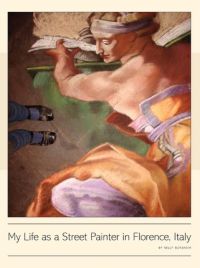
My Life as a Street Painter in Florence, Italy
by Kelly Borsheim
American sculptor Kelly Borsheim is living her dream, working as an artist in Florence, Italy (or Firenze as the city is called in Italian). She first visited Florence to see the marble sculptures of Michelangelo in person. Once there, she discovered the world of the Madonnari, meaning street painters. (Madonnaro is masculine singular. Madonnara is feminine singular.)
The madonnari work mainly in chalk and pastel. The art form “is believed to have started in the Mediterranean region. It can be found in Italy sometime in the 16th century and began as devotional drawings outside of churches and directly on the streets. The subject was typically the Madonna, hence the name of these artists.”
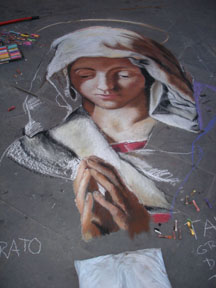
Today in Florence, the madonnari on Via Calimala mainly draw copies of artworks by old masters such as Botticelli, Caravaggio, Leonardo da Vinci, and of course, Michelangelo.
Borsheim began street painting in Florence in 2007. “The group had 28 artists when I joined, but only three squares in which they were permitted to draw… Claudio organized a rotation schedule in a way such that the same artist was able to draw in a different square each time his shift came up. The system was fair and worked well, considering the abundant number of artists.” In addition to the native Italians, her colleagues come from a variety of countries, including Ireland, Japan, and Korea.
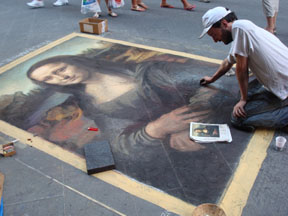
“Madonnari tend to work from 9:30 or 10:00 a.m. until midnight to complete one large street painting… Because one cannot paint on a wet surface, each artist was responsible for washing his own work at the end of the day, typically midnight. In the morning, the driver of the street sweeper could pass over the work and the square would be somewhat clean and dry by the time the next artist arrived.”
“The question that street painters probably receive the most often is: How can you create such beauty only to have it destroyed shortly thereafter?” As a sculptor, she works with stone and bronze—it doesn’t get more permanent than that. “However, what I discovered for myself is that there is a certain freedom in knowing in advance that the work will not last. Without the pressure of having to create a masterpiece, my brain shifts into a sort of ‘play’ mode that allows for experimentation. And that leads to learning.”
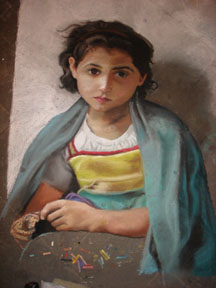
The book explains some challenges experienced in the life of a street painter. “I paid the permit fee for every Monday, late February through June, 2008. Unfortunately, that spring, many of my paintings were never finished. It rained almost every single Monday for months.” Another challenge is how to improvise. “I began to run out of flesh tones while painting the male figure of Bouguereau’s ‘The Abduction of Psyche’… Zecchi and all the other art supply stores were closed by that hour, so I did the best I could with the pigments I had left.”
The book also explains how the madonnari protested changes to the permit system, including a steep increase in fees. Ultimately, city hall decided not to issue any permits. However, they continued to create street art within the rules of ‘manifestazione’ (demonstration) under the Italian Constitution. “This meant, though, that we could only draw ONE artwork per day, although it could legally be slightly larger than our previously defined dimensions… I first resisted this situation because I like working alone… But I came to enjoy working with others. Drawing side by side with another improves your quality time together and I got to know several of my colleagues better than I would have if I had simply been working in a neighboring square.”
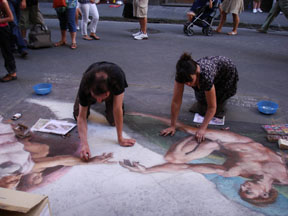
Borsheim also documents side trips to street painting festivals in Nocera Superiore, a small town in the mountains north of Italy’s famous Amalfi coast, and Grazie di Curatone, south of Verona.
The book includes 330 color photos of finished street drawings, works in progress, parades and festivals, as well as other sights in Italy.
Borsheim, Kelly. My Life as a Street Painter in Florence Italy. Borsheim Arts Studio, 2011. Buy from Amazon.com
Disclosure: As an Amazon Associate I earn from qualifying purchases. I received a review copy of this book.